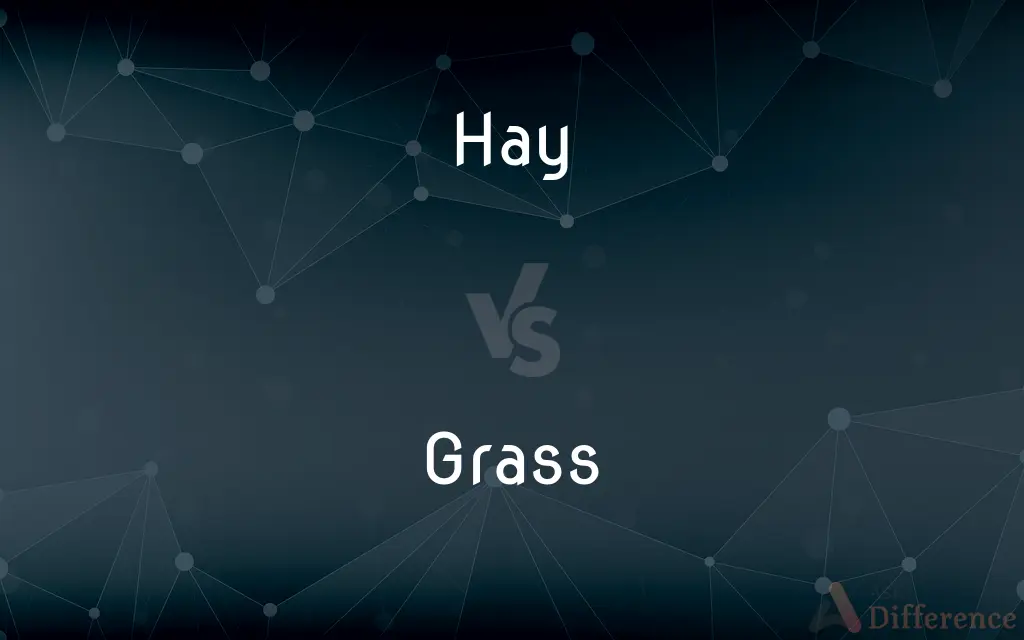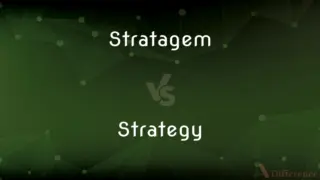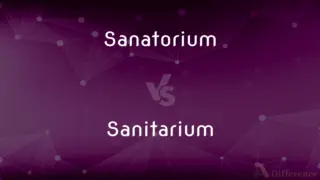Hay vs. Grass — What's the Difference?
Edited by Tayyaba Rehman — By Fiza Rafique — Updated on October 29, 2023
Hay is dried grass or legumes stored for feeding animals, while grass refers to green plants with jointed stems, often covering ground. Both are associated with fields but have different uses and stages.

Difference Between Hay and Grass
Table of Contents
ADVERTISEMENT
Key Differences
Hay is essentially grass that has been cut, dried, and stored for animal feed. It serves as a primary food source for livestock, especially during periods when fresh grass is not available. Grass, on the other hand, denotes green, growing plants that cover fields, lawns, and meadows.
The process of making hay involves cutting grass or other plants, allowing them to dry in the sun, and then baling or storing them for later use. Grass, conversely, is a living plant that can be found in gardens, parks, and natural landscapes, growing freely and serving as a ground cover.
One significant distinction between hay and grass is their nutritional content. Hay, because it's dried, has lost most of its moisture, concentrating its nutrients. Grass, being fresh, contains more water and provides immediate nourishment when grazed upon by animals.
Another notable difference lies in their uses. While hay is primarily used as feed for livestock, grass has a broader range of applications. Grass is not only a source of fresh food for animals but also plays a pivotal role in landscaping, sports fields, and erosion control.
Hay and grass, though related, cater to different needs. Hay is a preserved form of nutrition for animals, especially vital during winter months, while grass enhances landscapes, offers recreational spaces, and serves as a direct food source for many creatures.
ADVERTISEMENT
Comparison Chart
Nature
Dried plant material
Living green plant
Primary Use
Animal feed
Ground cover, fresh feed, landscaping
Moisture Content
Low (dried)
High (fresh)
Production Process
Cutting, drying, baling
Growing, mowing
Nutritional Aspect
Concentrated nutrients due to drying
Fresh nutrients with more water content
Compare with Definitions
Hay
Harvested and dried green fodder.
Hay production is essential for dairy farms.
Grass
Ground cover plants used in landscaping.
Grass requires regular watering during summer.
Hay
Preserved grass for times when fresh feed is scarce.
During droughts, hay prices often rise.
Grass
A member of the grass family.
Hay
Grass that's been mowed and dried for feeding livestock.
The horses prefer hay when fresh grass isn't available.
Grass
The members of the grass family considered as a group.
Hay
A baled or stored dry plant material for animals.
Stacking hay properly prevents it from getting moldy.
Grass
Any of various plants having slender leaves similar to those of a grass.
Hay
Dried grass or legumes used as fodder.
The farmer stored hay in the barn for the winter.
Grass
Ground, as on a lawn, that is covered with grass or similar plants.
Hay
Hay is grass, legumes, or other herbaceous plants that have been cut and dried to be stored for use as animal fodder, particularly for large grazing animals raised as livestock, such as cattle, horses, goats, and sheep. However, it is also fed to smaller domesticated animals such as rabbits and guinea pigs.
Grass
Grazing land; pasture.
Hay
Grass or other plants, such as clover or alfalfa, cut and dried for fodder.
Grass
(Slang) Marijuana.
Hay
(Slang) A trifling amount of money
Gets $100 an hour, which isn't hay.
Grass
(Electronics) Small variations in amplitude of an oscilloscope display caused by electrical noise.
Hay
To mow and cure grass and herbage for hay.
Grass
Chiefly British Slang An informer.
Hay
To make hay on (a patch of land).
Grass
To cover with grass.
Hay
To make (grass or other plants) into hay.
Grass
To grow grass on.
Hay
To feed with hay.
Grass
To feed (livestock) with grass.
Hay
(uncountable) Grass cut and dried for use as animal fodder.
Grass
To become covered with grass.
Hay
(countable) Any mix of green leafy plants used for fodder.
Grass
To graze.
Hay
(slang) Cannabis; marijuana.
Grass
Any plant of the family Poaceae, characterized by leaves that arise from nodes in the stem and leaf bases that wrap around the stem, especially those grown as ground cover rather than for grain.
Hay
A net set around the haunt of an animal, especially a rabbit.
Grass
(countable) Various plants not in family Poaceae that resemble grasses.
Hay
(obsolete) A hedge.
Grass
(uncountable) A lawn.
Hay
(obsolete) A net placed around the lair or burrow of an animal.
Grass
Marijuana.
Hay
(obsolete) An enclosure, haw.
Grass
An informer, police informer; one who betrays a group (of criminals, etc) to the authorities.
What just happened must remain secret. Don't be a grass.
Hay
(obsolete) A circular country dance.
Grass
Sharp, closely spaced discontinuities in the trace of a cathode-ray tube, produced by random interference.
Hay
The letter for the h sound in Pitman shorthand.
Grass
Noise on an A-scope or similar type of radar display.
Hay
To cut grasses or herb plants for use as animal fodder.
Grass
The season of fresh grass; spring or summer.
Hay
To lay snares for rabbits.
Grass
That which is transitory.
Hay
A hedge.
Grass
Asparagus; "sparrowgrass".
Hay
A net set around the haunt of an animal, especially of a rabbit.
Grass
(mining) The surface of a mine.
Hay
Grass cut and cured for fodder.
Make hay while the sun shines.
Hay may be dried too much as well as too little.
Grass
(transitive) To lay out on the grass; to knock down (an opponent etc.).
Hay
To lay snares for rabbits.
Grass
To act as a grass or informer, to betray; to report on (criminals etc) to the authorities.
Thesaurus:rat out
Hay
To cut and cure grass for hay.
Grass
(transitive) To cover with grass or with turf.
Hay
Grass mowed and cured for use as fodder
Grass
(transitive) To feed with grass.
Grass
(transitive) To expose, as flax, on the grass for bleaching, etc.
Grass
(transitive) To bring to the grass or ground; to land.
Grass
Popularly: Herbage; the plants which constitute the food of cattle and other beasts; pasture.
Grass
An endogenous plant having simple leaves, a stem generally jointed and tubular, the husks or glumes in pairs, and the seed single.
Grass
The season of fresh grass; spring.
Two years old next grass.
Grass
Metaphorically used for what is transitory.
Surely the people is grass.
Grass
Marijuana.
Grass
To cover with grass or with turf.
Grass
To expose, as flax, on the grass for bleaching, etc.
Grass
To bring to the grass or ground; to land; as, to grass a fish.
Grass
To produce grass.
Grass
Narrow-leaved green herbage: grown as lawns; used as pasture for grazing animals; cut and dried as hay
Grass
German writer of novels and poetry and plays (born 1927)
Grass
Animal food for browsing or grazing
Grass
Street names for marijuana
Grass
Shoot down, of birds
Grass
Cover with grass;
The owners decided to grass their property
Grass
Spread out clothes on the grass to let it dry and bleach
Grass
Cover with grass
Grass
Feed with grass
Grass
Give away information about somebody;
He told on his classmate who had cheated on the exam
Grass
Green plants with jointed stems covering ground.
The grass is greener on the other side of the fence.
Grass
A common plant of fields and lawns.
Kids love playing on freshly mown grass.
Grass
Herbaceous plants grazed by herbivores.
Cows feed on grass in the pasture.
Grass
A term for various plants forming dense vegetation.
Grass can transform a barren land into a green meadow.
Common Curiosities
Why is hay dried?
Drying preserves the hay, prevents mold, and concentrates nutrients for feeding animals.
What's the main purpose of hay?
Hay serves as a primary food source for livestock, especially during times when fresh grass isn't available.
How is hay typically stored?
Hay is often stored in bales, either in barns or under cover to protect it from moisture.
Can humans eat grass?
While humans can eat grass, it's hard to digest, and its nutrients aren't easily accessible to us.
How often should grass be mowed?
It depends on growth speed and desired length, but many lawns are mowed weekly or biweekly.
Why is grass green?
Grass is green due to chlorophyll, a pigment vital for photosynthesis.
Is all grass suitable for making hay?
No, specific grasses and legumes are cultivated for hay production due to their nutritional content.
Can grass grow in the shade?
Certain grass types can grow in shade, but they might not be as lush or thick as in full sunlight.
Is hay always made from grass?
While often made from grass, hay can also be made from legumes like alfalfa.
Can hay be used for purposes other than feed?
Yes, hay can also be used for bedding, mulch, and in arts and crafts.
How does grass reproduce?
Grass reproduces through seeds, and some types can spread via runners or rhizomes.
What's the difference between hay and straw?
Hay is dried grass or legumes for feeding animals, while straw is the dried stalks of cereal plants, used mainly for bedding.
What are the common types of grass for lawns?
Common types include Kentucky bluegrass, Bermuda grass, and fescue.
How long can hay be stored?
If kept dry and protected, hay can be stored for several years without significant nutrient loss.
What's the best time to cut grass for hay?
The best time is usually before the grass seeds mature and when it's dry to preserve maximum nutrients.
Share Your Discovery

Previous Comparison
Stratagem vs. Strategy
Next Comparison
Sanatorium vs. SanitariumAuthor Spotlight
Written by
Fiza RafiqueFiza Rafique is a skilled content writer at AskDifference.com, where she meticulously refines and enhances written pieces. Drawing from her vast editorial expertise, Fiza ensures clarity, accuracy, and precision in every article. Passionate about language, she continually seeks to elevate the quality of content for readers worldwide.
Edited by
Tayyaba RehmanTayyaba Rehman is a distinguished writer, currently serving as a primary contributor to askdifference.com. As a researcher in semantics and etymology, Tayyaba's passion for the complexity of languages and their distinctions has found a perfect home on the platform. Tayyaba delves into the intricacies of language, distinguishing between commonly confused words and phrases, thereby providing clarity for readers worldwide.














































